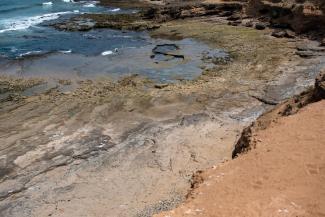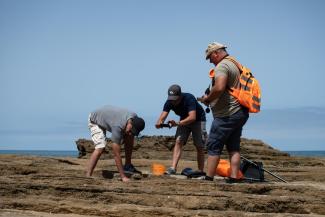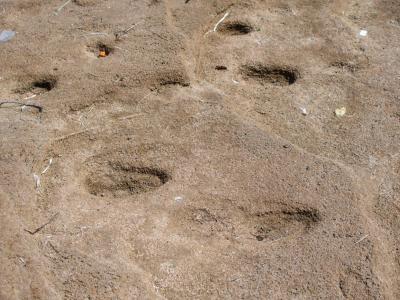
In a study published in January 2024 in the journal Scientific Reports, an international research team led by the Université Bretagne Sud, in partnership with the Centre Européen de Recherche et d'Enseignement des Géosciences de l'Environnement and other university laboratories, has presented the oldest known footprints in North Africa and the southern Mediterranean.
|
Key facts to remember:
|
Footprints dating back 90,000 years...
Eighty-five human footprints, about 90,000 years old, have been discovered on a rocky beach in Larache on Morocco's north-west coast. The footprints, those of Homo sapiens, were left by a minimum of five individuals, ranging from children to teenagers and adults. These prints are mainly oriented towards the sea, and give a striking picture of what the search for marine resources by these Homo sapiens, who lived on or along the Larache coast, might have looked like.
... preserved by a salt crust.
These imprints were left on the seaward side of a sandbar that made up the upper part of the intertidal beach, a location that probably corresponded to the limit of the swash zone, i.e. the area over which water washes up on the beach after a wave has broken. Edward Anthony, a researcher at the Centre de Recherche et d'Enseignement en Géosciences de l'Environnement, suggests that the footprints may have been preserved momentarily by a salt crust, before being buried by new sedimentary deposits that would have started their solidification process.
The Larache footprint site is 90.3 thousand years old (plus or minus 7.6 thousand years) and represents one of the largest and best preserved Upper Pleistocene footprint sites in the world. It is also the only documented site in North Africa and the southern Mediterranean. North Africa, and Morocco in particular, has yielded the first occurrences of Homo sapiens, notably with the fossils from the Jebel Irhoud prehistoric site.
Understanding paleoenvironmental conditions in the Upper Pleistocene.
The discovery of the Larache footprints is further proof of the importance of North Africa, and the Moroccan region in particular, in the evolution of Homo sapiens. Further work is currently underway to analyse dozens of other tracks found at the site, to better understand the size of the group of Homo sapiens found there. It will also contribute to our understanding of the paleoenvironmental conditions that prevailed during the Upper Pleistocene.

Photo of 90,000-year-old footprints discovered on a rocky beach at Larache on Morocco's northwest coast.
Credit: Mouncef Sedrati (Geo-Ocean, Université de Bretagne Sud).
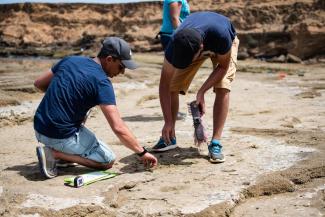
Two researchers measure the footprints found.
Credit: Mouncef Sedrati (Geo-Ocean, Université de Bretagne Sud).
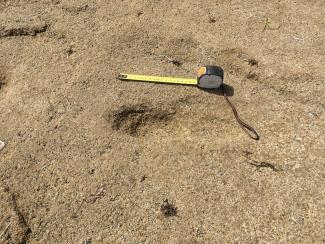
Photo of 90,000-year-old footprints discovered on a rocky beach at Larache on Morocco's northwest coast.
Credit: Mouncef Sedrati (Geo-Ocean, Université de Bretagne Sud).
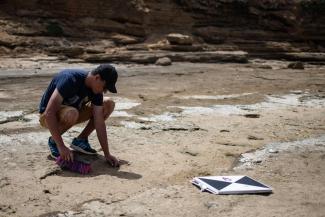
A researcher measures a footprint in the gridded area.
Credit: Mouncef Sedrati (Geo-Ocean, Université de Bretagne Sud).
Reference: Sedrati, M., Morales, J.A., Duveau, J. et al. A Late Pleistocene hominin footprint site on the North African coast of Morocco. Sci Rep 14, 1962 (2024).
Photo credits: Mouncef Sedrati (Geo-Ocean, Université de Bretagne Sud).
Article published March 18, 2024.


